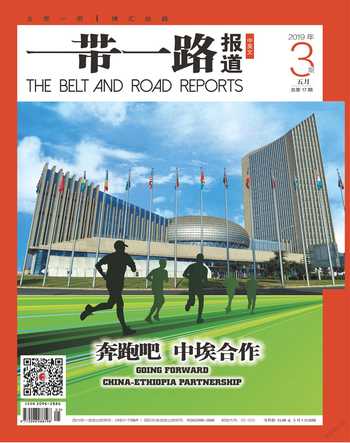欧亚联通 圆梦一场百年的憧憬
2019-09-10

Eurasia connectivity: a century-old aspiration
请用三分钟介绍一下中国的“一带一路”倡议。这是笔者常常遇到的挑战,甚至常有老外要求用一句话给“一带一路”下定义。
2016年2月2日下午,笔者应德国外交部邀请在“盘点中国的‘一带一路’倡议”内部研讨会上,本来要求十分钟介绍“一带一路”进展与中欧互联互通平台时,又遇到了这种情形。德国外交国务秘书和大使在开幕式致辞时抛出一系列问题:“一带一路”到底想干什么?是否意味着欧亚大陆地缘政治的回归?如何处理与欧盟睦邻政策、中亚政策的关系?与欧盟、欧安组织的互联互通计划如何对接?……笔者发言时先得占用正式发言的三分钟做出简洁回应。当晚,应我国驻德国大使馆邀请,在“全球之桥”(global bridge)晚宴上,又用三分钟向在座的德国联邦议员、企业家和美国前驻德国大使、记者阐述“一带一路”。
如果一句话来描述“一带一路”,就是互联互通,实现包容性全球化。
为什么说全球化不够包容?自从古丝绸之路中断后,欧洲人走向海洋,通过地理大发现殖民世界,开启所谓的全球化。然而,这是真正的全球化吗?打开“夜晚的世界”图可以发现,只有日本、北美和欧洲发达国家沿海地区灯火辉煌,证明实现了现代化,而在世界的其他地方卫星上看不到灯光,依然生活在“贫困的黑暗”之中,所以“一带一路”就是要让所有人在晚上都有电,见到光,这才是搞工业化。按照世界银行数据,当今世界产出的80%来自于沿海地区的一百公里的地带,因为地球71%的面积被海洋覆盖,90%的贸易通过海洋进行。这种西方中心的海洋型“全球化”其实是“部分全球化”(partial globalization),我们还需要更多的互联互通,帮助内陆地区寻找海洋,帮助南南国家实现工业化,助推人类文明的共同复兴,打造更包容的全球化(inclusive globalization).
如何实现欧亚互联互通?15世纪奥斯曼土耳其帝国的崛起切断了两千年的古丝绸之路,欧洲人被迫走向海洋,导致欧亚大陆文明的衰落。重振丝绸之路成为丝绸之路沿线许多国家的共同梦想。然而自古以来,打通欧亚大陆靠战争、靠征服,从大流士、亚历山大、恺撤、奥斯曼、成吉思汗到近代的西方殖民战争。人类步入铁路时代,欧亚铁路计划为实现欧亚大陆互联互通的百年梦想提供技术支撑。于是有了德国一战前的柏林一巴格达铁路规划,有了联合国开发计划署的欧亚大陆桥设想。在人类从传统铁路迈入高速铁路的进程中,中国实现了弯道超车,在短短10年时间修建了2万公里的高铁(占世界的3/4以上),一跃成为高铁大国、高铁强国。这就是中国提出“一带一路”的底气。而中国充足的外汇储备和强大的建造能力,则是“一带一路”建设的重要资本。

“一帶一路”提出实现“五通”:政策沟通、设施联通、贸易畅通、资金融通、民心相通,这就从时间上超越欧洲一体化的商品、劳动力、服务及货币的四大自由流通;空间上实现陆海联通,东西呼应,实现规模、系统效应,才能彻底降低物流成本,提升内陆地区的比较竞争力,让欧亚大陆互联互通计划获得可持续发展,超越了古丝绸之路与传统全球化。
在“一带一路”框架下,圆梦欧亚大陆互联互通的百年憧憬,携手开创全球化3.0版,融通中国梦与世界梦:
如果我们把作为古代东西方贸易与文明交流之路的丝绸之路称为全球化1.0时代:其单元是文明,载体是欧亚大陆,动力是贸易+文化,遵循的“和平合作、开放包容、互学互鉴、互利共赢”的丝路精神;把近代西方开创的全球化称为全球化2.0时代:以民族国家为单元,通过海洋实现全球贸易+投资扩张,确立西方中心世界:那么,“一带一路”是21世纪的跨洲际合作倡议,不只是打通历史上中断的丝绸之路,而是借助丝绸之路的历史概念,开创创新型全球化——全球化3.0时代:秉承“万物互联”(ANT all things connected),运用3D打印机、大数据和智慧城市,推动E-WTO进程,开发和应用包容性技术——改变传统技术让强者更强、弱者更弱的状态,创新和实施包容性制度安排——推动国际贸易、投资规则更加公正、合理、包容,开创包容性全球化——实现持久和平、共同繁荣的千年梦想。
“Please brief on China's Belt and Road Initiativewithin three minutes." This is a question I alwaysmeet, and some foreigners even ask me to give adefinition of the Belt and Road with one sentence.
In the afternoon on February 2, 2016, I was invitedby German Federal Foreign Office for an internalsenunar themed "Taking stock of China's Belt andRoad Initiative". Originally I was asked to introduce theprogress of the Initiative and "EU-China ConnectivityPlatform" within 10 minutes, yet I encountered thesame question again. At the opening ceremony, the StateSecretary of the Federal Foreign Office, Germany, raisedquestions one afier another: what's the purpose of theBelt and Road? Does it mean the regression of Eurasia'sgeopolitics? How to balance its relations with the EU'sGood Neighbor Policy and Central Asia policy? Howto get it integrated with the connectivity plans of EUand the Organization for Security and Co-operation inEurope (OSCE)? I was asked to spare three minutesfrom my formal speech to answer these questionsconcisely. At that evening, I attended the "GlobalBridge" banquet at the invitation of Chinese embassyin Germany. Once again,l briefed on the Belt and Roadfor Bundestag members, entrepreneurs, former U.S.ambassador to Germany, and reporters within threeminutes.

The Belt and Road can be described as "connectivityand inclusive globalization".
Globalization is not inclusive enough, why? Sinceancient Silk Road was disrupted, Europeans started toembrace the sea, and then colonized the world throughthe Age of Discovery. Yet, is it globalization in realsense? Open the map of "the world at night", youcan see that well-illuminated belts can only be foundin Japan, North America, and developed Europeancountries, where modemization has been realized;yet no light can be found in other parts of the worldfrom a satellite, where people are still living in "thedarkness of poverty". The Belt and Road is designedto make people around the world have access topower and light at night, which is the prerequisite ofindustrialization. Data of the World Bank shows that80% of world output comes from the lOOkm-belt ofcoastal regions. With 71% of earth surface covered bysea, 90% of trade has been done via sea. Such West-centric ocean-based "globalization" is actually "partialglobalization". That is why we need to realize greaterconnectivity: help inland regions to find sea, helpsouth-south countries to realize industrialization, pushfor the common revitalization of human civilizations,and build more inclusive globalization.
How to realize Eurasia connectivity? In the15th century the rise of Ottoman Empire cut off thetwo millennia-old ancient Silk Road. As a result,Europeans were forced to walk into the ocean,hencethe decline of Eurasia civilization. It is the sharedaspiration of many countries along the Silk Roadto revitalize the route. Yet since ancient times, fromDarius I (the Great), Alexander the Great, JuliusCaesar, Osman I, Genghis Khan, to westem colonistsin modern times, they all connected different partsof Eurasia through wars and conquering. Enteringrailway age, Eurasian railway project has providedteclmological support for Eurasia connectivity,a century-old aspiration. Then came the Berlin-Baghdad railway planning, and the UNDP's visionof Eurasia Land Bridge. As conventional railway isreplaced by high-speed rail, China has realized cornerovertaking: building 20,000 kilometers (more thanthree quarters ofthe world total) of high-speed railwaywithin 10 years and thus emerging as a big powerof high-speed railway. These achievements makeChina confident enough to propose the Belt and Road.Meanwhile, China boasts abundant foreign exchangereserve and construction capability, which underpinthe Belt and Road.
The Belt and Road Initiative features five targets:policy coordination, facilities connectivity unimpededtrade, financial integration, and people-to-peoplebond. In time dimension, it will enable the free flowof commodities, labor, services, and currencies whichwere not aclueved by the European Integration. Inspace dimension, it will connect land and sea, andWest and East, realize scaled system effects, thusreducing logistics costs once for all and enhancing thecomparative competitiveness of inland regions. In thisway, Eurasia connectivity plan will realize sustainabledevelopment while transcending ancient Silk Roadand traditional globalization.
The Belt and Road Initiative is designed to realizethe century-old aspiration of Eurasia connectivity andintegrate Chinese Dream and the world's dream byjointly launching Globalization 3.0.
If we call the ancient Silk Road, which enabledwestern and eastern trade and cultural exchanges,as an era of Globalization l.0, then its unit wascivilization, vehicle was Eurasia, and driver wastrade + culture, in following the Silk Road spirit of"peaceful cooperation, openness and inclusiveness,mutual learning, and win-win"; if we call the modernWest-initiated globalization as Globalization 2.0,then its unit was national state, and ocean was usedto realize global trade + investment expansion and tobuild a West-centric world; then the Belt and Roadis a transcontinental cooperation initiative of the21st century and aims at not only connecting theonce-broken Silk Road, but more importantly, usingthe historic concept of Silk Road to embark on anew era of innovation-driven globalization, namelyGlobalization 3.0: following the vision of "ANT allthings connected", 3D printer, big data and smart citywill be leveraged to push for E-WTO, and developand apply inclusive technologies. While breakingaway from the outdated rule of"let the strong strongerand the weak weaker", efforts will be made to identifyand implement inclusive institutional arrangements,realize fairer, more rational and inclusive internationaltrade and investment rules, bring about inclusiveglobalization, and materialize the millennia-old dreamof enduring peace and common prosperity.
